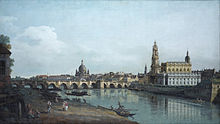Vedute
A vedute ( Italian veduta 'view', 'view') is in the fine arts ( painting , graphics ) the realistic representation of a landscape or a cityscape . According to the art theory of the time, the goal is recognizability. All other aspects of image design (light and shadow, colors, etc.) are less important. In the history of garden art , the individual garden scenery that can be observed from one or more fixed points of view is often referred to as a vedute.
Development of the genre
The genre of vedute painting can be assigned to landscape painting . Mostly the term is used as a synonym for cityscape . Correctly, however, according to his Italian etymology, he must also all representations of landscape motifs in a quasi-realistic form, such as B. the views of the waterfalls of Tivoli , often painted in the 18th century . In research, the 17th century is generally given as the time of origin. One can, however, ask whether an artistic interest in city portraits should not begin much earlier. The woodcuts from the pilgrimage and travel reports of the mid-15th century - such as Reuwich's City Views of Venice or Jerusalem in Bernhard von Breidenbach's "Journey to the Holy Land" - may still represent a borderline case, as the focus there is more on documentary rather than artistic representation lies. However, there are certainly numerous paintings in Venetian painting around 1500 that depict the city architecture. The most prominent example is the cycle of relics of the cross (around 1495) designed by Gentile Bellini for the Scuola San Giovanni Evangelista . Today it is in the Venice Accademia . Bellini's “Procession on St. Mark's Square” (1495) or Vittore Carpaccio's “Miracle of the Relic of the Holy Cross” (1494) must at least be called a forerunner of vedute painting. The purpose of such cityscapes was to immortalize important monuments of historical or religious importance or special celebrations (processions, hereditary tributes, etc.). The copperplate engraving has made widespread use possible since the Baroque period .
Crucial for the enormous success of this genre was the Italian tourism of the English aristocracy, which reached its peak in the 18th century; it had become customary to take pictures of Roman antiquity or the northern Italian cities that one had visited to England as “souvenirs” from the Grand Tour to Italy. Bernardo Bellotto and Giovanni Battista Piranesi, however, departed from this concept: While Piranesi increasingly painted fantastic antique capriccios , Bellotto's paintings more and more testify to his preoccupation with contemporary reality.
composition
A vedute depicts a city panorama , usually with a view of a river, a canal, a square or a street, which draws the view downwards from a linear perspective . A distinction must be made between the “urban interior” and those images that deal with the interface between city and country and combine the two subjects of vedute and landscape (see also urban landscape ).
Vedute often has something like a prospectus or a backdrop . On the one hand, they document the particularly attractive and delightful sides of a landscape, a group of buildings, etc. in the sense of a "view" - a function that photography and postcard later took on - but also want to be an image itself, a painting, a work of art through function beyond being a document, to be perceived.
Representative of vedute painting
The Dutch-Italian painter Gaspar van Wittel (Vanvitelli ) is considered the "father of modern vedute" (Andrzej Rottermund 2005), who learned the painting trade in Holland but spent most of his life in Rome, where he passed on his experiences to the Italian masters. Through him the camera obscura was introduced as a tool in Italian vedute painting, which was also used by the main representatives of the Venetian school of vedute painting, Luca Carlevarijs , Giovanni Antonio Canale called Canaletto , Bernardo Bellotto called Canaletto , Francesco Guardi and Michele Marieschi . Giovanni Battista Piranesi , Domenico Quaglio and Rudolf Wiegmann are among the outstanding representatives of vedute painting . The Scot David Roberts is considered one of the most important vedute painters of the 19th century . Eduard Gaertner's metropolitan vedutas became known in 19th century Germany .
Gaspar van Wittel : Castel Sant'Angelo in Rome from the south
Giovanni Antonio Canale called Canaletto : Return of the Bucintoro to the Pier on Ascension Day , approx. 1727–1729 ( Pushkin Museum , Moscow)
Michele Marieschi : Rialto Bridge in Venice , around 1740 ( Hermitage , St. Petersburg)
Bernardo Bellotto called Canaletto : Nymphenburg Palace near Munich , ca.1761 (National Gallery, London)
Francesco Guardi : The Doge's Palace in Venice
Giovanni Paolo Pannini : Colosseum and Triumphal Arch of Emperor Constantine in Rome
literature
- Stephan Füssel , Rem Koolhaas, Hist. Museum Frankfurt / M. : Georg Braun , Franz Hogenberg : Civitates orbis terrarum (cities of the world). 363 copper engravings with 564 cityscapes reissued and annotated. After an original from the Historisches Museum Frankfurt. The original was published from 1572 to 1618. Taschen, 520 pages. ISBN 978-3-8365-1125-4
- Walter Koschatzky : The Masters of Vienna Vedute , Edition Szaal, Alt Wiener Vedute, Vienna 2002
- Sebastian Munster , 1544
- Filippo Pedrocco: Canaletto and the Venetian Vedutists , Scala, Antella (Florence), 1995.
- Werner Wilhelm Schnabel: City Pictures. Types and functions of city representations in Alba Amicorum from the 16th to 19th centuries . In: Christina Hofmann-Randall / Andreas Jakob (Ed.): Erlanger city views. Drawings, paintings and graphics from seven centuries . Erlangen 2003 (Publications of the City Archives Erlangen, 1), pp. 80-103.
- Christoph Wetzel : The Reclam Book of Art. Philipp Reclam jun., Stuttgart 2001, ISBN 3-15-010476-9 .
Web links
- The great art lexicon by PW Hartmann
- Zeit Online ( Memento from December 15, 2007 in the Internet Archive )







